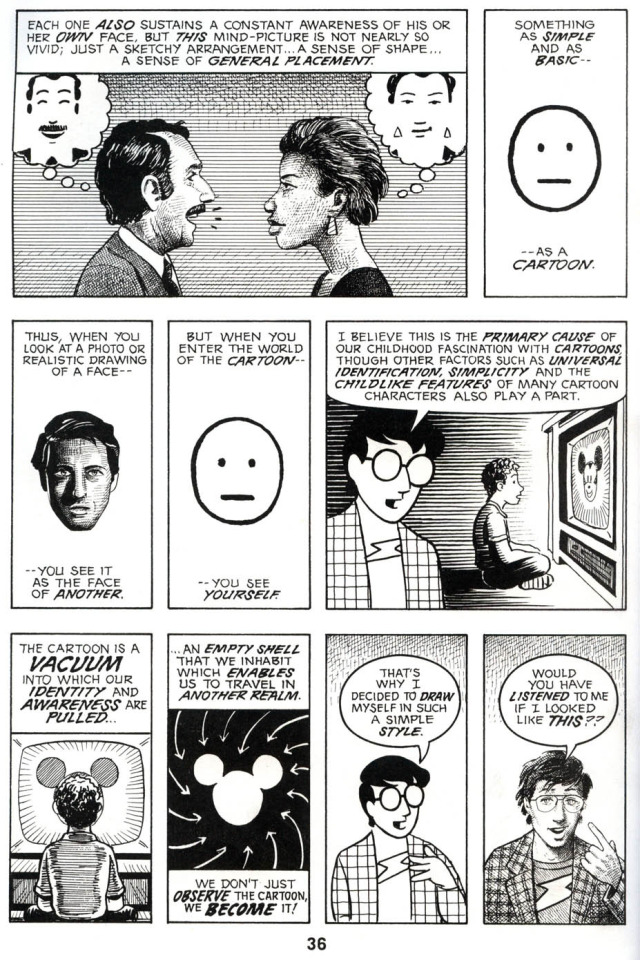In Praise of a Classic Text: Understanding Comics - Part II
Jul. 14th, 2025 20:17Last week I posted about Scott McCloud’s Understanding Comics - which, among many interesting arguments, postulates that when you look at a realistic drawing of a face, you see another, where when you look at a more simply drawn cartoon image - a smiley face, Charlie Brown, Minnie Mouse - you see yourself. I talked about the implication of that for certain kinds of fan art, and today I want to talk about a second interesting implication - specifically in terms of fannish identification with a character.
Interesting implication the Second: There’s a great book called How To Be Gay by David Halperin - (I did a Fanhackers post about it a couple of years ago) - in which he argues that his gay male students seemed to enjoy coded queer works - e.g. Broadway musicals, Hollywood melodramas, The Golden Girls, Steel Magnolias, Judy Garland and Adele, etc. - more than they enjoyed what Halperin calls “good gay writing,” - that is, “fiction about gay men written by gay men that gave voice to the gay male experience.” As I wrote in my Halperin post (and as I wrote about at length in my article, “Slash/Drag: Appropriation and Visibility in the Age of Hamilton” in Booth’s Companion to Media Fandom and Fan Studies) this makes perfect sense to me as a fangirl - many female fans find more to identify with in Spock or Mulder or Sherlock or Aziraphale than they do in female characters in serious literary novels who are dealing realistically with the problems that they face. That sounds like…a whole boatload of no fun, to be honest. (Personal sidebar: Do I want to read a serious literary novel about the travails of a female, middle-aged English Professor like myself? I do not. FWIW I basically had to be forced to watch even fluff like The Chair, and only because I knew everyone would ask me about it. I also personally don’t enjoy an academic AU, YMMV. But that doesn’t mean that I don’t find places of strong identification in the TV I watch and the fic that I read - it’s just not straight-up literal like that.)
But I think it’s McCloud who gives us the WHY of this phenomenon when he talks about how realist faces read as “another,” while more simply drawn faces provoke identification. There’s a way in which “good gay writing” - the voice of the gay experience - can feel disappointingly NOT YOUR EXPERIENCE - because of course there is not a single gay experience, and what you are likely to read is distorted by time and distance and age. I see it with my students, for whom the gay experience of the 1950s, 1960s, 1970s might as well be ancient Egypt - (or may be less familiar than ancient Egypt, Egypt kind of being its own fandom.) Anyway a lot of gay writing doesn’t speak to their problems or their issues, and while they’re interested in it, they don’t identify with it - and that can be really hard when you’re young and queer and feeling isolated, to feel like you don’t even relate to the people you are supposed to relate to. But in an odd way, the cartoons - the coded figures - don’t go out of style the same way. And they are places of broad identification over generations: We can all be Mama Rose or Dr. Frank N. Furter or sing “I Will Survive” – because it’s a metaphor (for being closeted, for being monstrous, for surviving, etc.) It doesn’t age the same way as, for instance, the novels of Ethan Mordden or Edmund White or plays like The Boys in the Band or Torch Song Trilogy. There’s a great passage in Stacy Wolf’s book, A Problem like Maria: Gender and Sexuality in the American Musical, where Wolf, a lesbian, talks about driving cross-country in a convertible singing, “My Man,” (“Can’t Help…Loving That Man of Mine!”) which, she claims, provoked her to write her book about lesbian readings of the musical. In short, Steven Universe can do work that “good gay writing” cannot–and so can fandom, with its cartoon heroes, animated and live action both.













